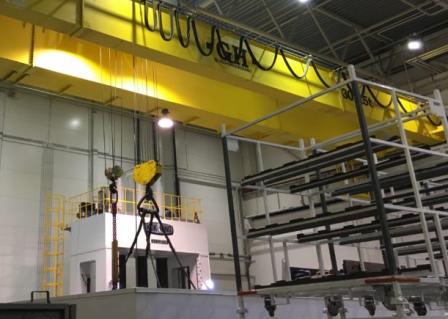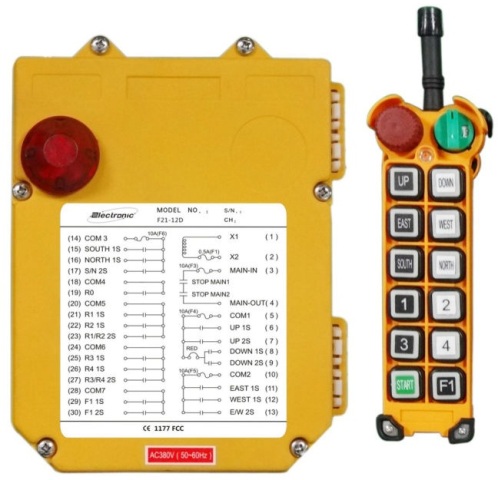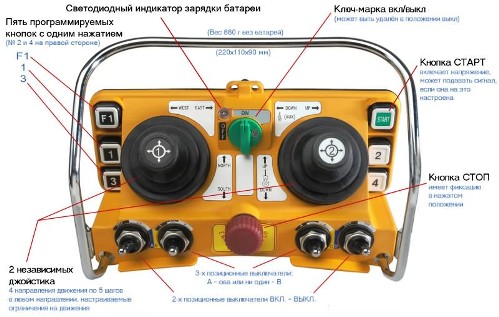Radio control of beam and bridge crane — advantages, operation, nuances of remote control
For many industries where there is lifting equipment, a radio control system for a jib crane or bridge crane is suitable. There are many such systems on the market today, but each of them has a number of undeniable advantages that an enterprise receives from the implementation of a radio control system at home.
The production process is modernized, safety for personnel and equipment is also increased, the overall productivity of the enterprise and work efficiency are improved, there is no need for a crane operator (its work will be carried out by an operator).
Advantages
Here is a list of the main advantages of a radio-controlled crane:
The load is very precisely lowered and raised, positioned in place, and from the cabin of the crane operator it is much more difficult to position the load in the right place, especially at high working heights.
The crane moves freely, its speed does not slow down even when working in heavily loaded warehouses, because the operator sees the territory and is better oriented, easier to move around the site than if he were in the cabin.
The movement of cargo on the territory of the facility is carried out along the optimal trajectory, under the full control of the operator, who at the same time can be not only a crane operator, but also a slinger.

From one control panel, the operator can control two cranes in turn, switching from crane to crane, for example, when it comes to a large workshop or work site where it is necessary to control several cranes at the same time.
With the infrequent lifting and moving of small loads in the workshop, it is much more convenient to use the remote control than for the crane operator to climb into the cabin every time or be there all the time.
Personnel safety is improved and working conditions are generally improved while the operator is working from the ground. Here it is possible to automatically control the area where the operator is, for example, if he enters a dangerous area, the crane will automatically stop and no one will be hurt.
The system is compatible with any faucet, it is enough to connect the control module to the electric drive and the entire configuration of the operation of the faucet will be preserved, the operating parameters will remain the same, but the flexibility will increase significantly.
The profitability of the enterprise will increase due to the absence of a crane operator who should be trained and trained. The crane operator, rigger and support worker can now be represented as a single worker.In addition, the number of empty strokes of the crane is reduced and this again increases the economy.
How it works
As you already understood, radio control of the crane is carried out remotely by the operator from the remote control. A small radio remote control, with a button or with joysticks, is very easy to use. A pair of joysticks or 4 to 12 buttons will allow the operator to control the crane from the ground. The remote control must also have an emergency button and may have buttons for signal commands.
Operator's console (click image to enlarge):
Remote control works at a distance of 50-100 meters from the operator to the receiver, which is usually enough. In this case, the receiver is mounted directly on the crane, near the controlled equipment. The remote control is in the hands of the crane operator when he is working, or for example hanging around his neck or on his belt while he is not using it. The operator will be able to operate the crane with one hand by grasping the remote control.
No need to worry about radio frequencies - they are selected so as not to interfere with other equipment, the crane control system has its own coded frequency range, for example for TELECRANE F24-60 it falls to 415 ~ 483MHz. The remote control is powered by batteries or rechargeable batteries.
In addition to the console and receiver, the system also includes a crane control module (often combined with a receiver in one housing), which is connected to the drives and thus serves as a bridge between the electronics and the crane's drive motors.In fact, it is a system for controlling a group of relays that are switched according to the commands given by the operator from the console and received from the receiver. The receiver and the control module are powered by the mains.

In metallurgy, in construction, in the mining industry, in the production of building materials, etc. — you can endlessly list the areas where it will be very convenient to transfer radio control cranes, because lifting and loading and unloading equipment is used in many places today.
Representatives of construction, production of various profiles, etc. they will certainly want to optimize their lifting costs, to pay for the work of a crane operator. The productivity of the enterprise will definitely increase, it is enough to choose the most suitable system, install and configure in their facility - it suddenly modernizes your business.
Nuances
Of course, depending on the current configuration of the crane, it will be necessary to more or less reconstruct the equipment in order to install the remote control system, but this task is typical for specialists.
A radio controlled crane will require the same regular maintenance as any other piece of equipment requiring extra attention. Workers will be required to complete a short course in operating a radio-controlled crane.

